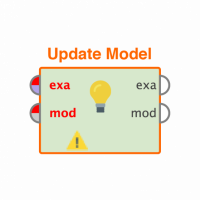The Altair Community is migrating to a new platform to provide a better experience for you. In preparation for the migration, the Altair Community is on read-only mode from October 28 - November 6, 2024. Technical support via cases will continue to work as is. For any urgent requests from Students/Faculty members, please submit the form linked here
Remove Duplicate Examples
Hi,
I'm working on some genetics data. I have 6151 examples and 157 attributes. My attributes are patient IDs and my examples are gene names. My goal is to transpose the matrix table. Here is a sample of my data set:

My problem now is I can't use the "Transpose" operator because there are duplicate row/example names. In order to transpose it, the attribute name needs to be unique. I wish to find all the pairs that have the same example names and edit their names. I was thinking about doing a loop, but I don't really know where to start and what operators to use to change the row names. Can somebody give me some advises on how to achieve this?
Thank you!
I'm working on some genetics data. I have 6151 examples and 157 attributes. My attributes are patient IDs and my examples are gene names. My goal is to transpose the matrix table. Here is a sample of my data set:

My problem now is I can't use the "Transpose" operator because there are duplicate row/example names. In order to transpose it, the attribute name needs to be unique. I wish to find all the pairs that have the same example names and edit their names. I was thinking about doing a loop, but I don't really know where to start and what operators to use to change the row names. Can somebody give me some advises on how to achieve this?
Thank you!
1
Best Answers
-
 cdaponte
Member Posts: 29
cdaponte
Member Posts: 29  Maven
You can use the Remove duplicates operator, and select the output that shows you the duplicates examples. Once you get the duplicates you can rename them with the operator "Rename" or "Replace".6
Maven
You can use the Remove duplicates operator, and select the output that shows you the duplicates examples. Once you get the duplicates you can rename them with the operator "Rename" or "Replace".6 -
 lionelderkrikor
RapidMiner Certified Analyst, Member Posts: 1,195
lionelderkrikor
RapidMiner Certified Analyst, Member Posts: 1,195  Unicorn
Hi @gracewei,
Unicorn
Hi @gracewei,
Nice challenge, but honestly, I don't see any solution to perform automatically what you want to do with RapidMiner's native operator(s)...
... however there is a (relativ) simple solution using a Python script to perform this task.
Basically, the script add a number to the name of the duplicate and this number is incremented according to the number of duplicate(s) of a name.
Concretely the output example set looks like that :
After executing this process, all the names/values of the "gene_name" attribute are unique et thus you can transpose your exampleset...
To execute this process, you need to :
- Install Python on your computer
- Install the Python Scripting extension in RapidMiner (from the Marketplace)
The process :<?xml version="1.0" encoding="UTF-8"?><process version="9.4.000-BETA"> <context> <input/> <output/> <macros/> </context> <operator activated="true" class="process" compatibility="9.4.000-BETA" expanded="true" name="Process"> <parameter key="logverbosity" value="init"/> <parameter key="random_seed" value="2001"/> <parameter key="send_mail" value="never"/> <parameter key="notification_email" value=""/> <parameter key="process_duration_for_mail" value="30"/> <parameter key="encoding" value="SYSTEM"/> <process expanded="true"> <operator activated="true" breakpoints="after" class="read_excel" compatibility="9.4.000-BETA" expanded="true" height="68" name="Read Excel" width="90" x="45" y="34"> <parameter key="excel_file" value="D:\Lionel\Formations_DataScience\Rapidminer\Tests_Rapidminer\Rename_Duplicates\Rename_Duplicates.xlsx"/> <parameter key="sheet_selection" value="sheet number"/> <parameter key="sheet_number" value="1"/> <parameter key="imported_cell_range" value="A1"/> <parameter key="encoding" value="SYSTEM"/> <parameter key="first_row_as_names" value="true"/> <list key="annotations"/> <parameter key="date_format" value=""/> <parameter key="time_zone" value="SYSTEM"/> <parameter key="locale" value="English (United States)"/> <parameter key="read_all_values_as_polynominal" value="false"/> <list key="data_set_meta_data_information"> <parameter key="0" value="gene_name.true.polynominal.attribute"/> <parameter key="1" value="Target.true.integer.attribute"/> </list> <parameter key="read_not_matching_values_as_missings" value="false"/> <parameter key="datamanagement" value="double_array"/> <parameter key="data_management" value="auto"/> </operator> <operator activated="true" class="python_scripting:execute_python" compatibility="9.3.000" expanded="true" height="103" name="Execute Python" width="90" x="313" y="34"> <parameter key="script" value="import pandas from collections import Counter # Counter counts the number of occurrences of each item from itertools import tee, count # rm_main is a mandatory function, # the number of arguments has to be the number of input ports (can be none) def uniquify(seq, suffs = count(1)): """Make all the items unique by adding a suffix (1, 2, etc). `seq` is mutable sequence of strings. `suffs` is an optional alternative suffix iterable. """ not_unique = [k for k,v in Counter(seq).items() if v>1] # so we have: ['name', 'zip'] # suffix generator dict - e.g., {'name': <my_gen>, 'zip': <my_gen>} suff_gens = dict(zip(not_unique, tee(suffs, len(not_unique)))) for idx,s in enumerate(seq): try: suffix = str(next(suff_gens[s])) except KeyError: # s was unique continue else: seq[idx] += suffix def rm_main(data): mylist = data['gene_name'] uniquify(mylist, (f'_{x!s}' for x in range(1, 100))) data['gene_name'] = mylist # connect 2 output ports to see the results return data"/> <parameter key="notebook_cell_tag_filter" value=""/> <parameter key="use_default_python" value="true"/> <parameter key="package_manager" value="conda (anaconda)"/> </operator> <connect from_op="Read Excel" from_port="output" to_op="Execute Python" to_port="input 1"/> <connect from_op="Execute Python" from_port="output 1" to_port="result 1"/> <portSpacing port="source_input 1" spacing="0"/> <portSpacing port="sink_result 1" spacing="0"/> <portSpacing port="sink_result 2" spacing="0"/> </process> </operator> </process>Hope this will help in the future ...
Regards,
Lionel
4

 Learner III
Learner III
Answers
You can use rapidminer operators to transpose and rename. But the tricky part is to create a new list of name without duplicates
<?xml version="1.0" encoding="UTF-8"?><process version="9.3.001"> <context> <input/> <output/> <macros/> </context> <operator activated="true" class="process" compatibility="9.3.001" expanded="true" name="Process"> <parameter key="logverbosity" value="init"/> <parameter key="random_seed" value="2001"/> <parameter key="send_mail" value="never"/> <parameter key="notification_email" value=""/> <parameter key="process_duration_for_mail" value="30"/> <parameter key="encoding" value="SYSTEM"/> <process expanded="true"> <operator activated="true" class="utility:create_exampleset" compatibility="9.3.001" expanded="true" height="68" name="Create ExampleSet" width="90" x="45" y="85"> <parameter key="generator_type" value="comma separated text"/> <parameter key="number_of_examples" value="100"/> <parameter key="use_stepsize" value="false"/> <list key="function_descriptions"/> <parameter key="add_id_attribute" value="false"/> <list key="numeric_series_configuration"/> <list key="date_series_configuration"/> <list key="date_series_configuration (interval)"/> <parameter key="date_format" value="yyyy-MM-dd HH:mm:ss"/> <parameter key="time_zone" value="SYSTEM"/> <parameter key="input_csv_text" value="gene-name,target-20,target-10,target-30 NAME,	1.0,	-2.0,	-1.0 STATE,	2.0,	3.0,	-2.0 NAME,	3.0,	8.0,	-3.0 CITY,	4.0,	13.0,	-4.0 NAME,	5.0,	18.0,	-5.0 ZIP,	6.0,	23.0,	-6.0 ZIP,	7.0,	28.0,	-7.0"/> <parameter key="column_separator" value=","/> <parameter key="parse_all_as_nominal" value="false"/> <parameter key="decimal_point_character" value="."/> <parameter key="trim_attribute_names" value="true"/> </operator> <operator activated="true" class="set_role" compatibility="9.3.001" expanded="true" height="82" name="Set Role" width="90" x="179" y="85"> <parameter key="attribute_name" value="gene-name"/> <parameter key="target_role" value="regular"/> <list key="set_additional_roles"/> </operator> <operator activated="true" class="generate_id" compatibility="9.3.001" expanded="true" height="82" name="Generate ID" width="90" x="313" y="85"> <parameter key="create_nominal_ids" value="true"/> <parameter key="offset" value="0"/> </operator> <operator activated="true" breakpoints="after" class="generate_concatenation" compatibility="9.3.001" expanded="true" height="82" name="Generate Concatenation" width="90" x="447" y="85"> <parameter key="first_attribute" value="gene-name"/> <parameter key="second_attribute" value="id"/> <parameter key="separator" value="_"/> <parameter key="trim_values" value="true"/> </operator> <operator activated="true" breakpoints="after" class="transpose" compatibility="9.3.001" expanded="true" height="82" name="Transpose" width="90" x="581" y="85"/> <operator activated="true" breakpoints="after" class="rename_by_example_values" compatibility="9.3.001" expanded="true" height="82" name="Rename by Example Values" width="90" x="715" y="85"> <parameter key="row_number" value="5"/> </operator> <operator activated="true" class="filter_example_range" compatibility="9.3.001" expanded="true" height="82" name="Filter Example Range" width="90" x="849" y="85"> <parameter key="first_example" value="4"/> <parameter key="last_example" value="4"/> <parameter key="invert_filter" value="true"/> </operator> <operator activated="true" class="parse_numbers" compatibility="9.3.001" expanded="true" height="82" name="Parse Numbers" width="90" x="983" y="85"> <parameter key="attribute_filter_type" value="all"/> <parameter key="attribute" value=""/> <parameter key="attributes" value=""/> <parameter key="use_except_expression" value="false"/> <parameter key="value_type" value="nominal"/> <parameter key="use_value_type_exception" value="false"/> <parameter key="except_value_type" value="file_path"/> <parameter key="block_type" value="single_value"/> <parameter key="use_block_type_exception" value="false"/> <parameter key="except_block_type" value="single_value"/> <parameter key="invert_selection" value="false"/> <parameter key="include_special_attributes" value="false"/> <parameter key="decimal_character" value="."/> <parameter key="grouped_digits" value="false"/> <parameter key="grouping_character" value=","/> <parameter key="infinity_representation" value=""/> <parameter key="unparsable_value_handling" value="fail"/> </operator> <connect from_op="Create ExampleSet" from_port="output" to_op="Set Role" to_port="example set input"/> <connect from_op="Set Role" from_port="example set output" to_op="Generate ID" to_port="example set input"/> <connect from_op="Generate ID" from_port="example set output" to_op="Generate Concatenation" to_port="example set input"/> <connect from_op="Generate Concatenation" from_port="example set output" to_op="Transpose" to_port="example set input"/> <connect from_op="Transpose" from_port="example set output" to_op="Rename by Example Values" to_port="example set input"/> <connect from_op="Rename by Example Values" from_port="example set output" to_op="Filter Example Range" to_port="example set input"/> <connect from_op="Filter Example Range" from_port="example set output" to_op="Parse Numbers" to_port="example set input"/> <connect from_op="Parse Numbers" from_port="example set output" to_port="result 1"/> <portSpacing port="source_input 1" spacing="0"/> <portSpacing port="sink_result 1" spacing="0"/> <portSpacing port="sink_result 2" spacing="0"/> </process> </operator> </process>After transformation,
Cheers,
YY
Lindon Ventures
Data Science Consulting from Certified RapidMiner Experts